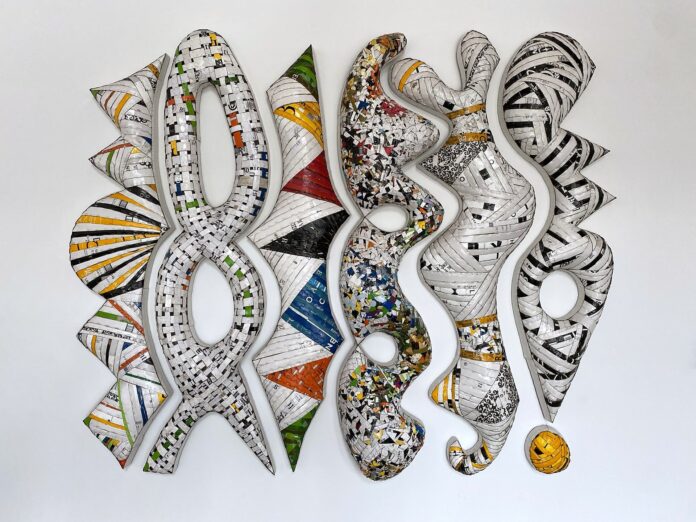Sculpture artist Ann Weber has taken dumpster diving to a new level. Transitioning from the world of clay to recycled cardboard as her medium of choice, the Los Angeles-based artist made a name for herself in the East Bay for years utilizing this ubiquitous disposable material. In large-scale works that evoke an anthropomorphic, figurative presence, Weber has yet to exhaust the infinite possibilities of the medium.
Born in Jackson, Michigan in 1950 and raised in the Midwest, Weber is a graduate of Purdue University in West Lafayette, Indiana (BA, Art History, 1972). After living in New York for 15 years and attending The New School for Social Research, Weber left her successful production pottery business in the Meatpacking District behind to pursue an advanced degree. Burned out and feeling a pull to explore other possibilities in clay along with new ways to live as an artist, Weber moved to the Bay Area to pursue graduate studies at California College of Arts and Crafts in Oakland (currently known as California College of the Arts in San Francisco).
“In the East Bay, I lived in Canyon, a small rural community behind the Oakland Hills, and later moved to Emeryville to the 45th Street Artists Co-op. I couldn’t imagine going back to New York or the Midwest where I was raised after discovering this magical place. Who could live anywhere else?” Weber told 48hills.
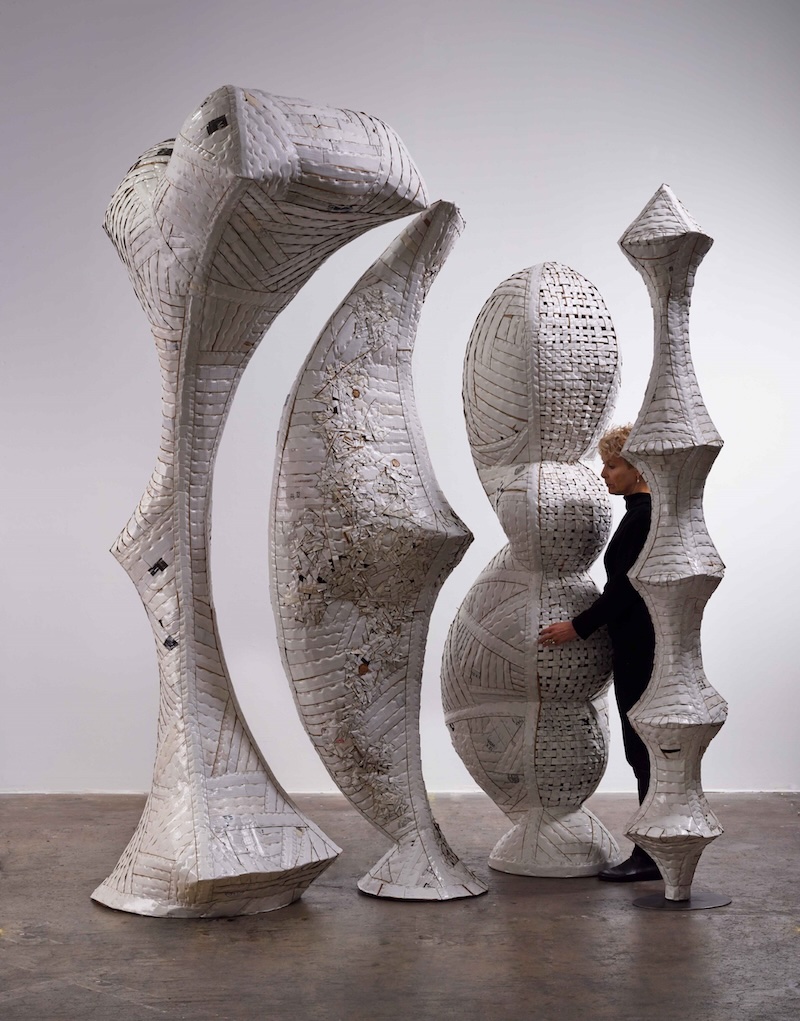
Inspired by renowned artist and art professor Viola Frey (1933-2004), who created monumental ceramic figures, Weber completed her MFA in Ceramics at CCAC in 1987, studying under Frey’s mentorship.
The transition from clay to cardboard occurred shortly after graduate school when she moved into a second-floor studio and decided she didn’t like the idea of hauling heavy materials into and out of the building. Taking a break from unpacking boxes in her new space, she had an epiphany.
“I’d experimented with a lot of different materials such as canvas in the style of Claus Oldenberg, printmaking, painting, plaster, and paper mâché in the style of Niki de Saint Phalle. When I moved to the new studio, the plaster pieces were too heavy to move since there were only stairs to access the studio. I sat in the studio with a big pile of flattened boxes in front of me from moving everything. I thought about Frank Gehry’s cardboard furniture. I bought myself a Pliers Arrow P-22 stapler, cut the boxes into strips, and started building forms in the style of coil pots. Twenty-five years later, I still find endless possibilities in this versatile material,” Weber said.
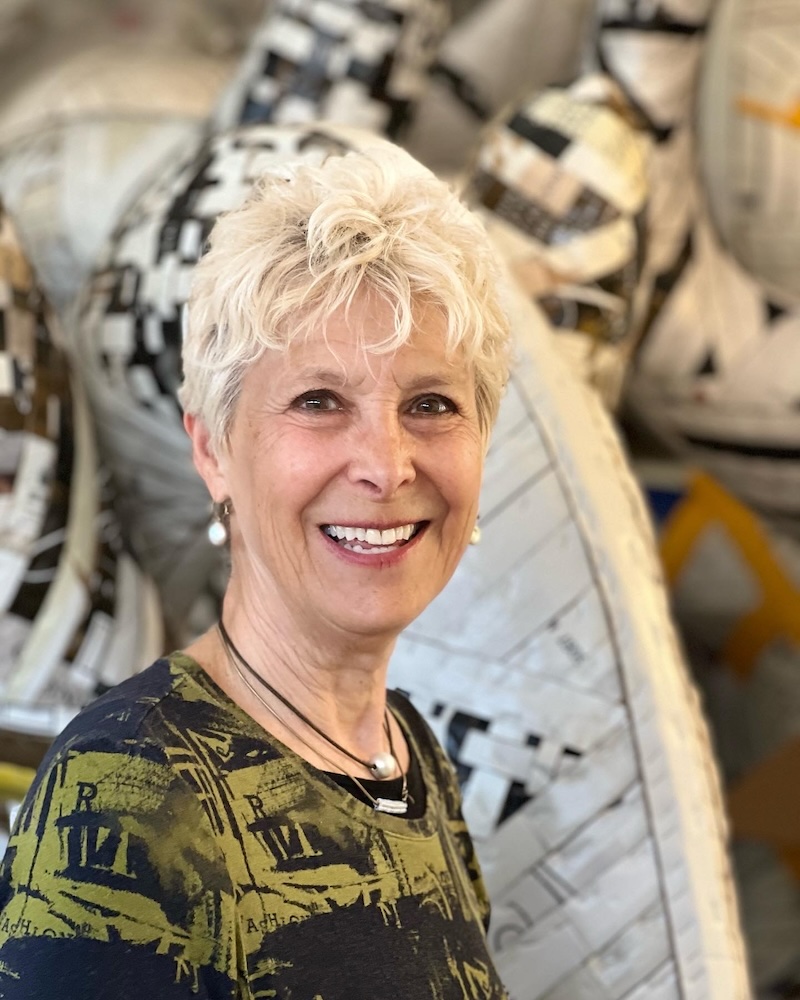
In hunting discarded cardboard around town, Weber selects scraps of all sizes and conditions, welcoming the random imperfections of uneven coloration, staples, or packing tape that will add to the texture of her pieces. She says she relates to the use of cardboard because of her resourceful Midwestern background. And because it’s so available, you can find it everywhere, it’s lightweight and it’s free.
“In these days of the hyper-capitalistic proliferation of shipping materials, my process and sculptures are even more relevant,” she said.
While most works remain in cardboard finished with a polyurethane coating, others are transformed by way of casting cardboard into fiberglass or bronze sculptures for public art projects. This choice is not only for the sake of resiliency of material, she says, but to illustrate that things are not always what they initially appear to be. Working with simple geometric shapes, Weber’s sculptures evolve organically somewhere between the abstract and representational, often suggestive of the human figure.
“The sculptures are symbolic of male and female forms and the natural world. I use architecture and art historical references to evoke memory, relationships, and morality in my sculpture,” she said.
Artists and architects who have influenced her work, apart from Frey, include Eva Hess, Louise Nevelson, Louise Bourgeois, Ellsworth Kelly, Frank Gehry, and Zaha Hadid. Most recently, she says her attention has been taken by graffiti and Piet Mondrian’s painting Broadway Boogie Woogie.
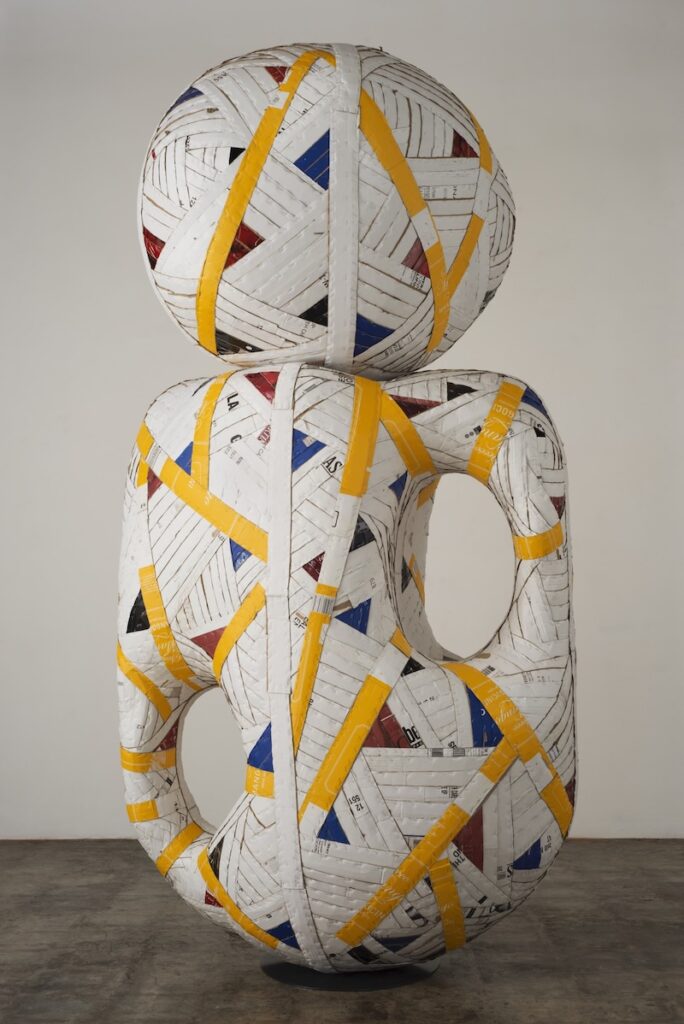
“I am also inspired by a huge community of friends and artists that keep me alive, support me, and give meaning to my life. During a period of obstacles,I had no idea so many people loved me. I have an ongoing series that I call Personages, which is an homage to all the people in my life who helped me,” Weber said.
After working diligently on her art while residing and maintaining a studio in the East Bay for 30 years, Weber made a move when she felt called to pursue her creative life in southern California.
“I ran into an artist friend, Josh Hagler, at an art opening in San Francisco after he had recently moved to Los Angeles. He told me he had had more attention for his paintings in eight months than he’d had in 12 years living in San Francisco. Oh shoot, I thought, I missed the boat. But the next morning, the more I thought about it, the more Los Angeles appealed to me,” she said.
Instead of thinking she was “too old and too entrenched” in her community to leave, Weber said to herself, “You’re only 65, you have 20 years left. Go see what it’s like.” She called a friend in Santa Monica to see if she could sleep on the couch for a month or two. “I sublet my studio for a year and two months later, in February 2015, I had found a studio and apartment in San Pedro for $1,200 a month,” she said.
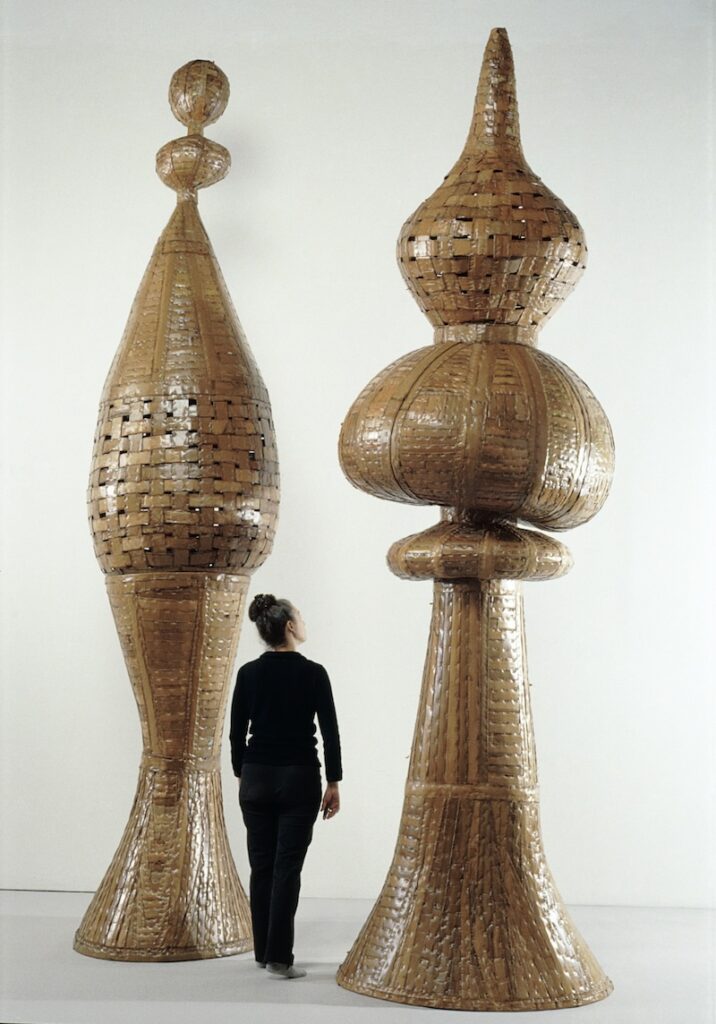
Weber admits, despite what Hagler told her, that even though there are a wide range of opportunities in Los Angeles, you still have to work hard to gain a foothold like anywhere else.
Weber spends just three hours a day, Monday through Friday, working in her studio. On the weekends, she attends art openings and meets up with friends to socialize. The choice of an abbreviated process is because the artist feels that making art is a lonely, isolating experience. She recharges by taking advantage of all the things going on in Los Angeles, particularly films, lectures, plays, and the arts in general, and by being with other people.
But she adds that she spends an inordinate amount of time working in her office on a computer answering emails and posting regularly on social media—Weber has 188,000 followers on Instagram she stays in the loop with. She also regularly sends out postcards about her work and upcoming events, which she says is an important task that takes up to three or four hours a day to complete.
“I keep up on what’s going on in my art community of Los Angeles and beyond on Instagram. I engage with people who leave comments. I think about what to post that will be interesting and helpful to artists and other people who wonder what it’s like to be an artist and what a day in the life of an artist is like. And I talk about the challenges of going to the studio every day,” she said.
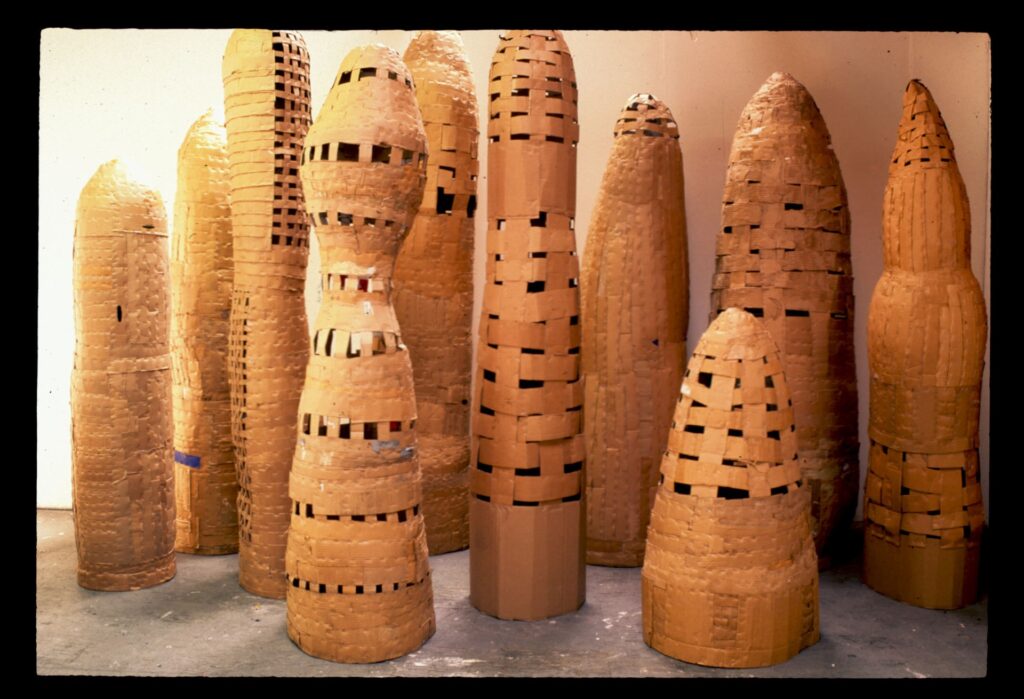
Weber also tries to do something special for herself every day. Once a week, she enjoys going to the Walt Disney Concert Hall—designed by world renowned architect Frank Gehry, by the way— to hear the Los Angeles Philharmonic perform. A weekend getaway might be a trip to Joshua Tree or Las Vegas. Weber also regularly hosts dinner parties at her house.
“I curate artists, curators, and press people. Some people I know, some I don’t. People are more than happy to come for a home cooked meal (I’m a former caterer) and I love connecting people,” she said.
Having recently received an inheritance, Weber hosted an Artist Residency Program in an eight-bedroom Villa in Puerto Vallarta which she has plans to repeat.
“The first AW Artist Residency consisted of 14 of us altogether, some staying for four weeks, some for two. It was an invitational residency bringing together artists, arts professionals, and writers from ages 23 to 72 throughout the United States for mutual mentorship, interchange of ideas, and collaboration. It was so inspiring and successful that I promptly reserved the Villa for 2024,” she said.
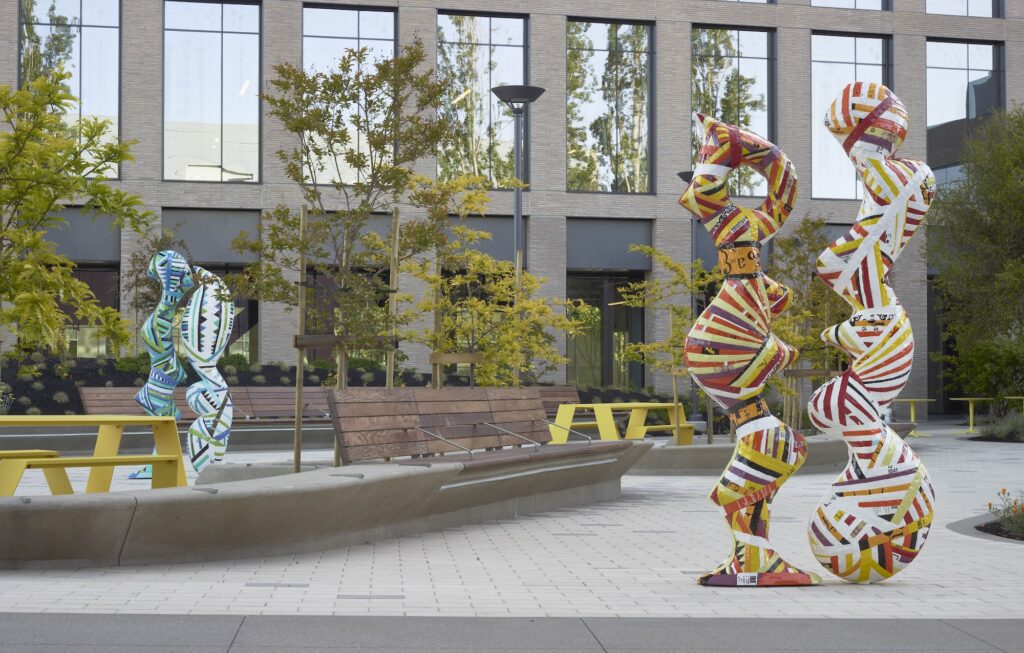
The work of Ann Weber is in numerous collections both nationally and internationally. She is represented by Wönzimer Gallery in Los Angeles, where she had her most recent solo show, “O What Fools We Mortals Be,” from November 10 – December 22, 2023. Her current exhibition is a solo show titled, “Ann Weber: 26 Miles” at Catalina Museum of Art and History on Catalina Island, California which opened on March 23 and continues until August 4, 2024.
As part of the Personages series, Weber just completed a public art project commissioned by BRE-BMR 5555 Hollis Street LP, Emeryville Center of Innovation. The pieces were fabricated at Metalphysic Sculpture Studio in Tucson, Arizona and hand painted by Rick Paris at Color Craft in Oakland. Weber says they reference personal relationships, how we fit together, our interconnectedness to everything in the world as well as to each other. As she constructed these pieces, the negative space of the armature was the basis for the positive space of the next sculpture.
“My abstract sculptures read as metaphors for life experiences, such as the balancing acts that define our lives. ‘How far can I build this before it collapses?’ is a question on my mind as I work,” Weber said. “Ultimately my interest is in expanding the possibilities of making beauty from a common and mundane material.”
For more information, visit her website at annwebersculpture.com and on Instagram.


